► 2030’s combustion engine ban is nearing
► So, one of these could be your next car
► Which family EV comes out on top?
VW’s new ID.3 takes on two other EVs with mainstream ambitions. But is the mass market ready for any of them? And are they ready for the mass market?
We brought together the ID.3 to face up to the popular Tesla Model 3 and the talented Polestar 2. Read on for our electric car three-way Giant Test.
VW ID.3: pre-flight briefing
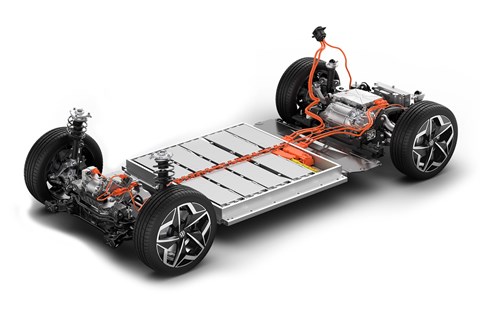
Why is it here?
Because there are so many tough questions to be asked of the ID.3 that Emily Maitlis ought to be doing the interview. VW is betting a fair bit of its considerable farm on the ID.3’s success: does it have the desirability an EV It-Car needs? Is it as usable as a Golf? Is its quality up to scratch? That last point is a genuine concern, given the endless delays and niggles the ID.3 has suffered pre-launch.
It may be priced lower than the Polestar and the Tesla – it’s a people’s car, after all – but that doesn’t mean it can’t have their want-one appeal, or fit into your life more neatly than they can.
Any clever stuff?
Packaging is the ID.3’s party piece, with its wheels pushed to the corners for maximum interior space. Although, as we’ve found, it doesn’t feel quite as roomy as you might expect.
VW claims the production process is net carbon neutral, with power from renewable energy sources and a carbon credit scheme in operation.
Which version is this?
This is the loaded-to-the-gunnels First Edition. In the UK that spec comes with a 58kWh battery, although 77kWh is available in Tour spec at close to £40k; the range starts at a tenner under £30k for Life.
The First Edition has 100kW charging capability fitted as standard, which enables the speediest possible top-ups at public sites. Entry-level cars have 50kW DC fast charging, which allows a decent top-up in half an hour.
Read our VW ID.3 review
Polestar 2: pre-flight briefing
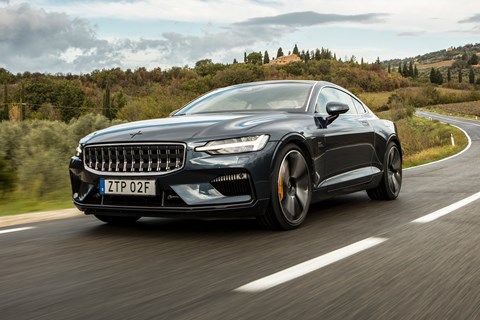
Why is it here?
Because it might just beat the Tesla at its own game. Clean, modernist styling, dual-motor all-wheel drive (and a more affordable single-motor on the way), and an interior dominated by its operating system. That and start-up brand chic.
Any clever stuff?
This is the first production car with Google’s Android-powered operating system for the infotainment and various other commands. Nav is by Google Maps, log in with your Google account and your contacts are ported in, and the voice interface is superb. It can still support non-Android and Apple devices too.
Which version is this?
The brand launched with the handsome two-door Polestar 1 (above). That was a hybrid, and an expensive one. The 2 is Polestar’s first pure EV, and it’s more accessible in both door count and price. There’s one version at launch, with two electric motors, 402bhp and 487lb ft. The optional Performance Pack (adding £5000 to the price) is fitted here: manually adjustable Öhlins dampers, big Brembo brakes, 20-inch wheels and various bits of gold trim. Based on sales data so far, it’s a popular option.
Read our Polestar 2 review
Tesla Modal 3: pre-flight briefing
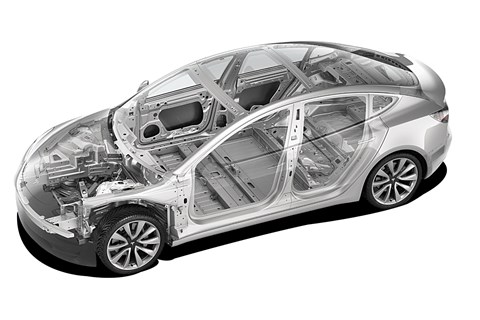
Why is it here?
The Model 3 has overtaken the Nissan Leaf as the biggest selling electric car ever. It’s the closest the US company has so far come to making an EV for the mass market. And, as we’ve discovered on previous tests, it drives very well by anybody’s standards.
It’s a more direct rival to the Polestar than the less expensive VW, but it should be on the shortlist for anyone looking to buy an EV for pleasure as well as practicality.
Any clever stuff?
The Tesla effectively bins conventional instruments, opting instead to put almost everything to the large central touchscreen.
Tesla is a huge manufacturer of batteries, and is at the forefront of battery tech, driven by Elon Musk’s habit of making wild promises that his team then try to deliver, with great results in terms of improved efficiency and reduced cost; the Model 3’s bang-per-buck is hugely impressive.
Which version is this?
The Tesla line-up is frequently tweaked with no notice but, at the time of writing, the current Model 3 line-up starts with the single-motor, rear-wheel-drive Standard Range Plus (WLTP range 267 miles). Then it’s the twin-engined, all-wheel-drive Long Range (360 miles) and this car, the Performance (quicker, but at the expense of a little range).
Read our Tesla Model 3 review
Enter the volts wagons
This just got a lot more pressing, didn’t it? If we really are going to be legislated out of new petrol and diesel cars within 10 years, it’s about time we took a bit more interest in the electric cars currently available, and those about to follow them. Will they offer anything comparable to the pleasure currently provided by internal-combustion engines, or do we need to adjust our expectations?
Here they come, white, grey and green silhouettes tiptoeing through the morning dew, the three newest clear-air temptations, the batteries in their bellies fully charged and the charging cables in their frunks or underfloor bonus boot meticulously furled.
One, the Tesla Model 3, is from a manufacturer that has only ever existed to build electric cars, and which has to a large extent defined what the premium electric car is all about; this is its smallest, most affordable model. Another, the ID.3, is the key product from the maker of the original people’s car as it transitions from traditional powertrains to EV. The third, the Polestar 2, comes from what used to be a performance sub-brand of Volvo, backed by the global might of Geely.
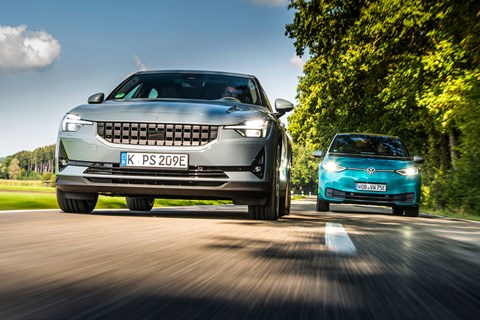
The three cars differ on shape, price and performance – but all are clearly aimed at the same rapidly growing market: not the earliest of early adopters, but those who want to be ahead of the curve on combatting the climate emergency, combining environmental responsibility with a smart package and a degree of driving enjoyment.
In an EV comparison many of the usual Giant Test criteria are overshadowed by the need to put remaining range, state of charge, charging infrastructure, available performance and average consumption under close examination. In this complex context, the driver’s self-restraint is a massive factor. Back off early, and you will likely get away with covering between 2.5 and 3.5 miles per kWh. Press on regardless, and these numbers can easily halve.
All-wheel drive with a motor on each axle is the formula for the Tesla and Polestar. VW will offer a similar layout soon, and the choice of battery sizes and power outputs will grow. For now, the two significantly more expensive cars are also significantly quicker. And who could resist, at least once in a while, slurping from the vast amounts of torque – 471lb ft in the case of the Tesla, or the Polestar’s 487lb ft – waiting to be uncorked? This is one area in which Tesla’s experience shows. Like Toyota with the Prius in the early days of hybrids, Tesla is simply better than the others at knowing how to manage batteries, e-motors and performance electronics for a clearly superior range. In contrast, the Polestar 2 over-promises when the batteries are full while under-delivering just before the white flag comes out. The ID.3 is less ambitious and more relaxed overall, and keeps a close eye on all charging eventualities.
Whichever electric car you’re in, the charging infrastructure is far from ideal; in the here and now, even Tesla’s impressive proprietary Supercharger network can involve a level of anxiety and delay that’s best avoided. It’s much more convenient to hook up to the mains at work, or at home, or in the case of the Tesla one of the faster V3 Superchargers. These deliver a phenomenal 250kW of charge – typically double what we consider to be the ultimate in charging in the UK – but there are fewer than 10 here right now. Model 3 owners must pay to use Superchargers, unlike owners of some older Teslas. (It can use regular public chargers too.)
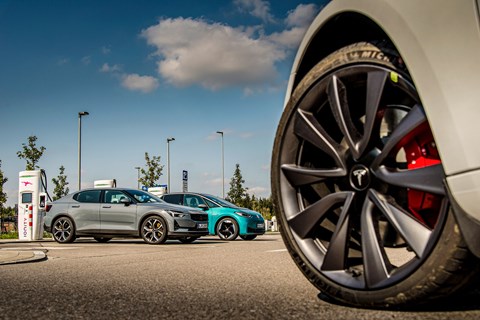
All three cars display state of charge, consumption, range and energy flow in detail on prominent touchscreens, which can be even more distracting than handling two smartphones at a time. The most challenging of these devices is the Tesla’s multi-tasking XXL device – recently declared unsafe by a German court. The VW splits the information between a small driver display with limited EV feedback and a larger tablet in the centre of the dash. In combination with the user-unfriendly multi-function steering wheel, the ID.3 is the undisputed king of belt and braces.
It doesn’t help that the Wolfsburg software is slow, capricious and prone to losing touch with the internet. The Polestar’s Android-based system is more user-friendly thanks to the first appearance of Google Automotive Services (now also on the EV version of the Volvo XC40), integrating streaming, navigation and voice control in a plausible and pragmatic fashion.
Polestar 2’s Google Automotive OS: does it work?
Imprecise touchsliders, concealed home buttons and unintuitive sub-menus let down all three, though owners will get used to them. But you can’t afford to ignore this vital information, which can help you minimise the amount of time spent waiting for access to a public charger, and then typically twiddling your thumbs for 30 to 40 minutes while the state-of-charge read-out climbs from 10 to 80 per cent. And that’s on a good day; charging can also involve dramatically varying electricity prices, long queues, out-of-order docking stations, illegible displays, randomly reduced charging power, busy hotlines… Nonetheless, the UK network continues to grow, with contactless payment now mandatory here.
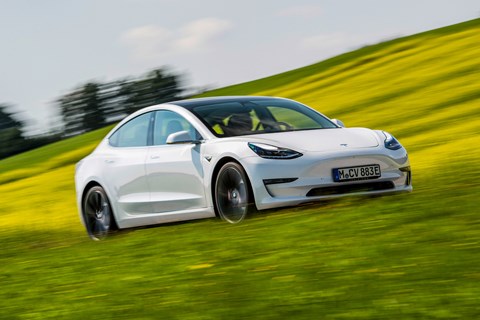
But on to happier matters, starting with the Model 3’s rapidity. Our mega-quick Performance edition pips the Ferrari Portofino’s 3.5sec 0-62mph time, and the top speed of 162mph matches the Taycan Turbo S. The Tesla takes off as if it’s been flung from an aircraft carrier’s catapult. It combines total traction and a brutal throttle response, with power and torque joining forces like an explosive chemical reaction. Full throttle feels simultaneously like both an implosion and explosion.
Is this the wrong approach, because these are not hardcore sports saloons but heroic planet savers? Yes and no. As long as the charge is CO2-neutral, and you know where the next charge is coming from, there is no real need to hold back. Even under pressure the Model 3 Performance can still cover 150 miles non-stop. Driven in similarly self-indulgent style (touching 100mph on the autobahn), its rivals run out of juice 25 to 45 miles earlier.
The Model 3’s Autopilot is allegedly fully prepared for future hands-off operation, but right now Tesla does not possess sufficient data and is still waiting for the EU regulators’ permission. In any case, who needs self-driving when a car can be this satisfying to drive yourself?
The Model 3’s lane-change, overtake and follow-to-stop tricks are aped by the Polestar 2 and ID.3, which do an even more accurate job through tighter radii and on tarmac devoid of road markings. The VW slows down by itself when approaching a built-up area, and it pulls over automatically should the driver nod off.
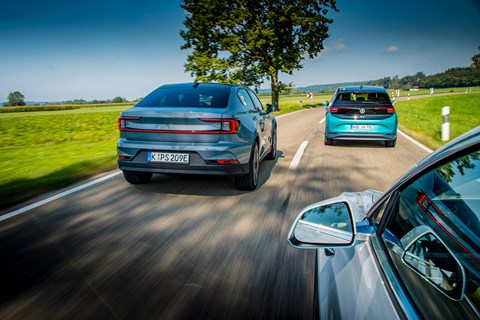
The Polestar has good performance figures – it can do 0-62mph in 4.7sec, and goes on to 127mph – and is a commendably involving drive. And although the VW is the least powerful of these cars, it’s lighter than the others, which helps give it a decent 0-62mph time 7.3sec. Top speed is, however, limited to 99mph, which fits the philosophical brief but is frustrating (in Germany, at least…) because the sorted chassis could handle more.
Despite the big wheels and the firm, occasionally jarring, suspension, the VW wins on ride comfort with its mix of general compliance and high-speed cushiness. But that win was there for the taking thanks to its uncompromising rivals. Our Polestar is let down by its extra-cost sports suspension. Feeling better suited to racetracks than the road, the steel-sprung set-up employs a bunch of poltergeists, allows the advanced multi-link rear axle to squeal on rough turf, and at times feels too harsh in everyday circumstances. In this Performance specification, the Tesla is also too firm. It’s upset by transverse irritations, potholes and patched-up blacktop.
The ID.3 doesn’t only provide the smoothest ride by some margin, it’s also quieter all-round. EVs increasingly offer one-pedal operation, which can mean sharp braking when you lift off the accelerator. The intensity varies depending on the car maker’s ethos and can often be adjusted: to some drivers it’s a blessing, to others an unnatural curse; some are happier using the brake pedal for slowing down, and want the car to coast when they ease off the accelerator, not decelerate sharply.
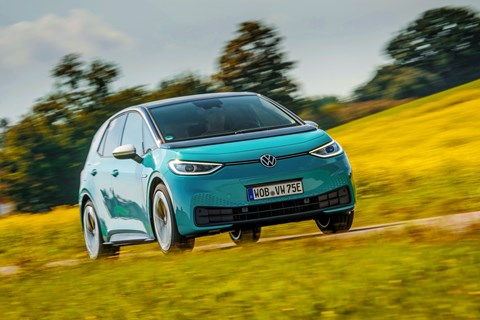
Which approach is more energy-efficient? Is it best to go one-pedal, and have the maximum amount of decelerative energy recaptured as electricity, or is it better to let a car coast, propelled by its momentum? There’s clearly no simple answer – so much varies from car to car, and from driver to driver. The Polestar 2 lets you choose from three different settings, whereas Tesla and VW have only two. At least the Tesla’s calibration is clear-cut, progressively increasing the deceleration before the vehicle comes to a full stop. The fixed set-ups chosen for the ID.3 are in contrast too much alike, and the slow-down effect is automatically suspended below 20mph. Enhanced coasting is, in all three cases, only possible in the highest-efficiency driving programme.
Thanks to its electric-optimised chassis, VW says the ID.3 fuses the footprint of the new Golf with the cabin space of the current Passat. It doesn’t quite feel like that. The ID.3 is not as wide as the conventional family car, and the rear headroom is to an extent compromised by the sloping roofline. Although it is 500mm shorter than the Passat, the hatchback does have a decent-size boot, at 385 litres (or 1267 with the rear seats down).
The Polestar’s rear passenger compartment is fine for six-footers, though their seating position is noticeably upright, and big passengers may find the door opening angle narrow. It’s spacious up front, and it can swallow up to 440 litres of luggage (combined front and rear, or 1905 litres with the rear seats folded). Like the VW, the Polestar has a large, practical hatchback opening, whereas the Tesla is a saloon with a narrow lid making it tricky to stuff its 425-litre conventional rear boot.
In the Model 3 the space behind the front seats feels tight, the thinly upholstered bench is positively uncomfortable, the dropping roofline impedes entry and exit, and on a hot day there is no sunshade to prevent the scalp from simmering under the glass canopy.
Tesla’s Toy Box: does it work?
After all these years, Tesla still has work to do on quality. The yawning panel gaps and the clatter of the closing doors are the most obvious examples, but not the only instances of ho-hum finish and assembly work.
The Polestar feels – and sounds – well put-together, using good-quality materials wherever you’re likely to come into contact with them.
Unlike Tesla and Polestar, who keep the options list short, VW offers a confusing array, and sometimes bundles the extras together in odd combinations. If you’re on the configurator, take your time. Some early ID.3s were criticised for patchy fit and finish. Ours was faultlessly put together, but the choice of materials was in places lower-rent than you’d expect from the self-proclaimed leading premium marque for the volk.
All three cars fall some way short of perfection, but all also have great strengths, and give reasons to be hopeful about the all-electric future that’s fast approaching.
Second opinion: Phil McNamara
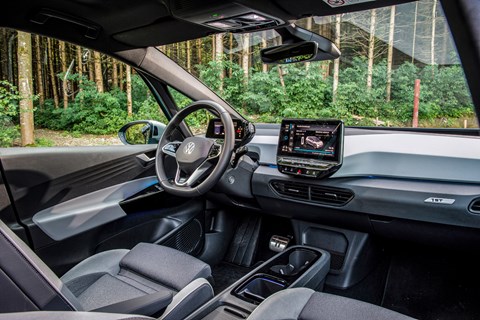
‘The ID.3 is understandably eclipsed in this ballistic company, but it has some solid virtues. Covering 2.8 miles per kWh during my full-on driving shows that the 58kWh battery can go beyond 150 miles. The dash-top lightbar is nicely communicative, flashing red for a braking warning, or easy-to-spot green when charging. The cabin is calming and spacious. But, crucially, this little car stands for something huge: VW’s rebirth from emissions sinner to electric evangelist. That’s hugely welcome with the 2030 engine ban looming.’
Second opinion: James Taylor
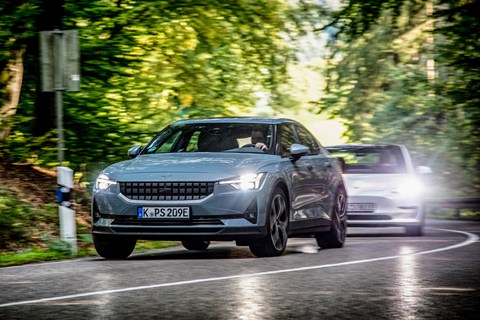
‘If the ID.3 is designed to be a car for the everyman, the Polestar and the Tesla vie for the affections of more affluent style-conscious buyers. Which edges it on feelgood factor? The Polestar flies out of the blocks with a nicely put together, soothingly understated cabin. Its tallboy centre console is a contrast with the Model 3’s airily open-plan layout, and the Polestar feels more like a ‘normal’ car as a result. Although the Model 3 is the oldest car in this test, it still looks, feels and drives like a welcome visitor from the future.’
Final reckoning: the race for second hots up
These are ground-breaking cars, made even more fascinating now the stopwatch is counting down to end the combustion engine’s days. The ID.3 bears hefty baggage, spearheading VW’s zero-emissions push to draw a line under Dieselgate, and the ambition to deliver an all-electric people’s car to rank alongside the Beetle and Golf.
‘People’s car’ is spot-on. The ID.3 is a five-door hatch which focuses on human necessities such as spaciousness (mostly), civility and comfort (mostly). With a range starting at £29,990 it’s also the most attainable, some £7500 less than the cheapest Model 3 and £16k below the Polestar. The ID.3 is pleasant to drive, with the punch of a middleweight boxer, accurate, easygoing steering and ample cornering grip, though few rear-drive frolics.
Maybe it’s the weight of expectation, but there’s something underwhelming about the ID.3, and not just in the low-rent plastics to trade-off the expensive hardware, or the lumbering infotainment. Think of the ID.3 as a cute alternative to the Nissan Leaf, with rational strengths to lure more punters into the electric mainstream.
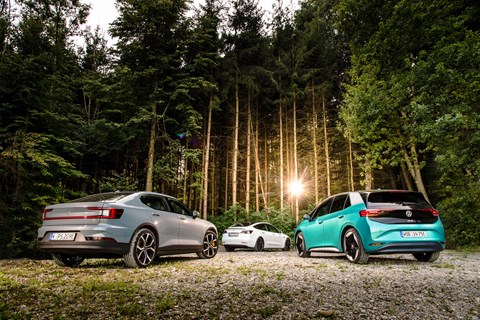
Car enthusiasts want more than pleasing; they want passion. With its beefy proportions, the Polestar 2 is nice to be seen in, and the imaginative fabrics and finishes (clawmarked trim!) make it the nicest to be in, too. The Google-powered infotainment handles English-language inputs adroitly, whereas the VW labours as if your navigation instructions are in its second language.
The Polestar’s strong performance sits squarely in this test’s middle ground, with more of that head-jarring thrust so intrinsic to EVs. The steering is more delicate and vivid, but the superior dynamics do impact the cruising refinement and ride comfort. Efficiency and charge time are not its strongest suits either.
With its first-mover advantage, Tesla knows how to pamper batteries to extract XL range in the lesser models and XXXL performance from the £56k flagship. It lags the legacy car makers on quality, and the minimalist cabin can’t match the Polestar for surprise and delight, save for a screen big enough to monitor America’s airspace.
But with performance to match a Porsche Taycan, alert steering and a sorted chassis, the Model 3 is in a league of its own. Even a couple of years of familiarity have not blunted its appeal. The baby Tesla was the breakthrough EV. Its newer rivals remain pretenders to the throne.
Read more CAR comparison tests here